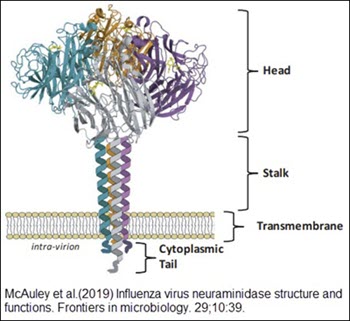Clade 2.3.4.4b H5N1 neuraminidase has a long stalk
A newly published study in mBio investigates the characteristics of neuraminidase (NA) in clade 2.3.4.4b of the H5N1 avian influenza virus, highlighting the predominant presence of long-stalk variants. The study emphasizes that clade 2.3.4.4b H5N1 viruses, which have rapidly expanded globally since 2020, primarily express a long NA stalk, in contrast to the shorter stalks prevalent in earlier highly pathogenic strains.
Neuroaminidase stalk: Stalk length governs the height of the globular domain and hence its access to substrates and also its interactions with HA.

Neuraminidase long-stalk variants are associated with an enhanced potential for transmission among mammals. This structural feature facilitates viral interaction within the respiratory tract and mucosal surfaces, thereby promoting efficient spread. In contrast, truncated NA stalks have been linked to increased virulence in poultry but may compromise transmission efficiency in mammals, leading to reduced viral shedding and dissemination. Neuraminidase stalk length shortening is frequently observed during adaptation of influenza A virus between avian species (1,2), where it can be associated with increased lethality and transmission (3,4). Long-stalk variants have also been shown to confer greater stability and provide additional glycosylation sites, which may contribute to immune evasion and viral fitness in mammalian hosts. Conversely, truncated stalks can diminish stability, thereby affecting viral replication and persistence in respective hosts.
These contrasting properties underscore the ongoing evolution and adaptation strategies of the H5N1 virus in response to shifting host environments and selective pressures.
The study found that currently circulating clade 2.3.4.4b H5N1 viruses predominantly harbor a long-stalk NA, a feature that may enhance mammal-to-mammal transmission and potentially increase the risk of human-to-human spread. The continued evolution of NA stalk composition suggests an ongoing adaptation of the virus across various host species.
1. Li J, Dohna HZ, Cardona CJ, Miller J, Carpenter TE. Emergence and genetic variation of neuraminidase stalk deletions in avian influenza viruses. PloS one. 2011 Feb 23;6(2):e14722.
2. Sorrell EM, Song H, Pena L, Perez DR. A 27-amino-acid deletion in the neuraminidase stalk supports replication of an avian H2N2 influenza A virus in the respiratory tract of chickens. Journal of virology. 2010 Nov 15;84(22):11831-40.
3. Stech O, Veits J, Abdelwhab ES, Wessels U, Mettenleiter TC, Stech J. The neuraminidase stalk deletion serves as major virulence determinant of H5N1 highly pathogenic avian influenza viruses in chicken. Scientific Reports. 2015 Aug 26;5(1):13493.
4. Li Y, Chen S, Zhang X, Fu Q, Zhang Z, Shi S, Zhu Y, Gu M, Peng D, Liu X. A 20-amino-acid deletion in the neuraminidase stalk and a five-amino-acid deletion in the NS1 protein both contribute to the pathogenicity of H5N1 avian influenza viruses in mallard ducks. PLoS One. 2014 Apr 17;9(4):e95539.











